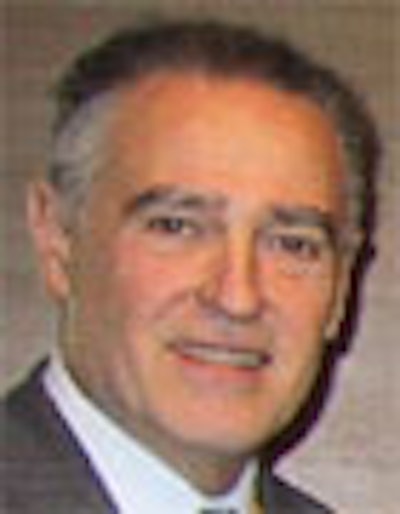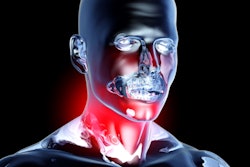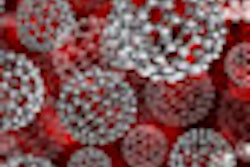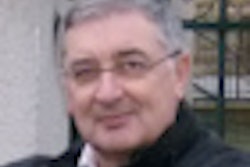
We are pleased to present our annual interview, and our first bilingual interview, with the president of the European Congress of Radiology. Professor Antonio Chiesa is director of the department of radiology at the University of Brescia in Italy. At our request, Prof. Chiesa answered our questions in Italian; his remarks here have been translated into English.
What's new at this year's ECR meeting?
ECR 2005 has added a number of new features. First on the list is the new Categorical Course dedicated to "Essentials of Neuroradiology." The course includes 27 lectures presented by European experts, with the principal goal of providing participants with the essential elements needed for correct interpretation of neuroradiological pathology.
Neuroradiology is a discipline of its own and, therefore, all major hospitals are now equipped with special units dedicated to neuroradiology. However, some neuroradiological cases may occur in smaller facilities, which often cannot afford to have a neuroradiologist.
| Prof. Antonio Chiesa, M.D. |
The course is intended for general radiologists who need to report neuroradiological cases, and I'm sure they'll find the course to be extremely useful. Another important feature of the congress is the Primer on Molecular Imaging. In the past two years there have been several interesting scientific presentations on this topic, but these presentations did not extend to the interests of the "average" radiologist. Indeed, many radiologists are unaware of many terms in this new branch of imaging, which is still considered, perhaps correctly, as confined to a few research centers. Ten lectures in the primer are aimed at exploring different fields in molecular imaging today, with the goal of familiarizing the audience with this novel branch of radiology.
The growth of interactive courses and lectures is another aspect of ECR 2005. Success in past years has prompted us to offer a wider choice, as reflected in the interactivity of the Foundation Course for the Chest. Because foundation courses are dedicated to topics of broad interest (the abdomen in 2004, the chest in 2005), interactivity should make them more interesting to the audience.
The best of the new features is a congress area called "IMAGINE -- The intelligent department." It is a large space built and equipped as a radiology service containing, instead of radiological rooms, areas that illustrate the most recent advances in terms of Integrating the Healthcare Enterprise (IHE), PACS, CAD, electronic atlases, 3D visualization, and robotics for surgical applications. The project, which is truly innovative, will prompt radiologists to consider this futuristic work environment as similar to the one they will inhabit themselves in the near future.
The last new feature is organizational in nature. There is a new "slice center" that is completely electronic and activated by the badge of the presenter, who will have access to the computer following an order of priority determined by the time of his or her presentation.
The 2005 ECR Meets program will feature Hungary, Italy, and Japan. What will these radiologists will be teaching us?
The ECR Meets program has reached its third edition, and the long list of countries asking to participate is a tribute to its growing success. This year we wanted to continue to involve a country in Eastern Europe, Hungary, and one from the Far East, Japan.
Hungary, which is close to Vienna both geographically and historically, will present five young radiologists, one from each of the five Hungarian university schools. Each speaker will have a specific topic to emphasize the different interests of the different schools.
Japan's contribution will be different. Under the title "Oriental Pearls," the delegation will demonstrate to European radiologists the primary topic of Japanese radiology: early cancer and its prompt diagnosis, from the gastrointestinal tract to the liver, the biliary ducts, and the pancreas.
Finally, Italy will present five young radiologists who will share a common topic: focal lesions. Each speaker will deal with the most innovative study techniques for identifying and characterizing focal lesions from the brain to the kidneys, especially malignant ones.
One of the 2005 New Horizons sessions covers the emerging field of nanotechnology. As director of the School of Nuclear Medicine at Brescia, what do you feel are some of the main considerations for nanotechnology in the radiology practice? Do you see the use of imaging as supporting the delivery of gene-specific nanotechnology agents?
First of all, the speakers invited to the New Horizons session will clarify for European radiologists the meaning of the word nanotechnology. This is an area that is waiting for clear definitions and universally accepted classifications. It is certainly difficult to predict, at present, which applications will support imaging in the monitoring and delineation of gene-specific agents.
A revolution is in progress for imaging -- from mere morphological representation of parts of the human body to dynamic representation of data and processes derived from the physiology of constituents of the human body. But it is difficult to predict to what extent this trend will progress toward the small, or the nano. More important, it is impossible to anticipate when nanotechnology studies will progress from research laboratories to routine practice.
Are there any other presentations you feel are not to be missed?
This is the most difficult question. If I were to name the title of a single scientific presentation, we would have a completely full room, with people unable to even enter, and several rooms empty for lack of an audience.
We have tried to organize a rich but balanced scientific program. Each day participants have the opportunity to choose between topics of general interest and those that are very specific. This has been done to accommodate the differences among attendees.
Indeed, together with those that can be considered "leaders" of European radiology, there are many radiologists who do not have access to advanced technologies, research laboratories, and well-organized hospitals. One of the strongest points of the ECR program during the past years has been its ability to combine advanced radiology with practical radiology, which is the one that most radiologists may practice in their facilities.
This year the ECR is allowing researchers to submit electronic poster presentations from home. Has the number of EPOS submissions increased as a result of the policy?
The EPOS program is a winner. This year presentation proposals have increased by 24%, demonstrating a high level of acceptance for this kind of "poster." Certainly the substantial increase may be explained in the presenters' ability to have their proposals accepted and incorporated in the scientific program without having to go to Vienna for the congress. On the other hand, the value of EPOS does not end within the few days of the meeting. EPOS lives throughout the year, and is accessible through the Internet to all members registered at the ECR, and with payment of a small subscription fee, even to those who cannot or do not want to subscribe to the European congress.
With regard to those who do not have the financial means to attend ECR, the "Invest in Youth" award seems to be a great opportunity to bring more young trainees to Vienna. What countries do most of the recipients come from, and are there any plans to expand this, or other financial aid programs?
This is the second year of the Invest in the Youth project and, somewhat surprisingly, we didn't even reach the maximum number of 500 grants available this year. This deserves careful analysis, and a search for better ways to promote the project. Clearly it has problems reaching its youth target. The Forum of Young Radiologists should do more to promote this project among the residents of different countries. Grant recipients have come mostly from the countries of Eastern Europe, although this year Spain has had the highest number of requests. This is probably due to the well-organized promotion in Bilbao, where the National Congress of Spanish Radiology was held in May of 2004.
At the University of Brescia you've participated in studies covering everything from nuclear medicine to MR myelography to digital chest radiography to oral cavity tumors. What is your favorite area of research currently, and in the coming months, what are some topics we'll be hearing about from your institution, or from other research centers in Italy?
For many years my favorite area of research has been head and neck. As a founding member of the European Society of Head and Neck Radiology (ESHNR), I can be considered as one of the ambassadors of this discipline, especially looking back at the years 1967-1968, when my interest in radio-otology first began. The responsibilities that come with directing a large radiology department, and the efforts required by the ECR, have progressively reduced my scientific responsibilities, which are now carried out by other members of my department.
They are currently proceeding with research projects in the field of neuroradiology, diagnostic and interventional, in the study of new molecules for paramagnetic contrast media, in the field of focal hepatic lesions, in the new area of ultrasound contrast agents, and, obviously, in head and neck radiology. In this latter field, our department is certainly the best known in Italy. It is difficult to predict the research topics that will be developed in other centers. Italian radiology is well represented at ECR, with a great variety of topics. These topics represent the fields of scientific interest of my Italian colleagues and only the time will evaluate their final results.
Unlike the U.S., Italy is fortunate enough to have a health system that cares for all of its citizens. But it is not without problems. Italian radiology in particular has suffered from a lack of research funds and equipment. At times, skilled young researchers have found they had no choice but to leave the country in order to find career opportunities. Can you comment on the state of Italian radiology today, and perhaps offer your prognosis?
In the panorama of Western radiology, Italian radiology is practically a world unto itself. First, the national situation is unusual because of the high number of radiologists, more than 10,000, and due to the absence of unemployment in this area. In contrast, there is a relative paucity of technicians or radiographers. As a result, some of the technical work is done by radiologists. There is also a lack of real centers of radiology research.
Looking at the ECR program this year and in previous years, it's easy to see that Italian contributions, although numerous, are always focused on clinical research, and almost never on other types of research. In my opinion, the absence of research centers is a direct consequence of our national health system, which, in order to take care of everybody, considers university schools as general hospitals. Therefore, with very few exceptions, an adequately financed and promoted radiological research program does not exist. With regard to radiological devices, the situation varies from region to region. In general, radiological equipment is technologically adequate in the vast majority of hospitals, both public and private.
If we look at statistics on the distribution of CT, MR, and PET scanners in Italy, we find percentages that are no lower than other, more technologically advanced European countries. But to tell the truth, if a young radiologist wants to have a career, he must go to a foreign country, where he will find not only organization and sufficient funding, but more important, a place where he will not be engulfed by bureaucracy. If I had to judge the future of Italian radiology, I would advise the youth to take advantage of the scarcity of radiologists in countries close to Italy and move there.
The growing importance of corporate funding affects research everywhere. In such a marketing-centered environment, how can radiologists, organizations, and medical institutions ensure that this research money is used ethically?
I think this question goes to the heart of the research problem. In general, research financed by public organs or not linked to corporations is becoming increasingly rare.
To remain in the radiological field, research on new molecules for contrast agents and their clinical applications are financed by industries that produce the contrast agents. They need our patients to develop study protocols, and we need their support to enter new areas of imaging, molecular or not. I see, rather pessimistically, that it would be very difficult to exit from this vicious circle. The only way out is represented by the behavior of radiologists, who must remain as ethical as possible, and by ethics committees that exist in every hospital, and must perform their role as guarantors with care.
Last year in the snow and ice of ECR 2004, you promised to bring a little bit of Italy to this year's meeting. How do you and your colleagues plan to warm up Vienna?
Promises must be kept, and in this regard, ECR 2005 will have an Italian flavor. The entire social program will have parts dedicated to Italy -- its music, songs, and folklore. The grand finale will be the ECR party on Monday evening, March 7, featuring Italian scenes in the splendid Ronacher Theater, which is being made available to ECR for the first time.
As for the rest, I don't believe the Italian spirit could improve on the already perfect organization in Vienna. And unfortunately, as an Italian from northern Italy, I do not share the traits typical of Italians in general. The expansiveness, the comic reply, the spontaneity -- have never been part of my character. So I wouldn't be surprised if we had a little snow and ice again this year in Vienna, despite the Italian president.



















